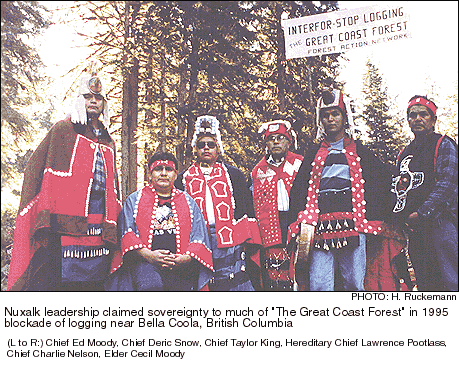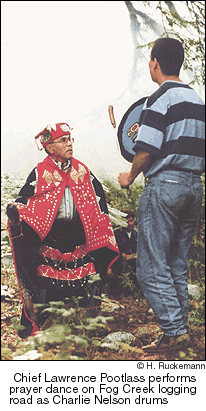
Nuxalk Reborn
by Korey Capozza
 |
by Korey Capozza |
|
 "The 'Land of the Nuxalk' has been lost for a long time, but a rebirth is happening: the Nuxalk are returning home to their traditional lands." Nuxalk Hereditary Chief Qwatsinas, Dec. 1997 In an area of Canada where unregulated clear-cut logging has transformed Indian ancestral territories and their way of life, an awakening is underway. The Nuxalk, Native inhabitants of British Columbia's central coast, are challenging the longtime presence of multi-national logging interests in their territories and demanding a stake in their own future. Along the way, the Nuxalk have also created a broad-based movement for the environmental protection of Indian ancestral lands and garnered support for Nuxalk Nation sovereignty . In 1995, a group of Nuxalk hereditary chiefs decided to take a stand against International Forest Products Ltd. (Interfor), the multinational logging company that has led the exploitation of Canada's central coast forests. Interfor had slated King Island -- known as Ista to the Nuxalk and a sacred place where, the Nuxalk believe, the first woman descended to earth -- for clear-cut logging. The chiefs invited environmental groups, including the Forest Action Network, to help. |
|
In early
September of 1995, a coalition of environmental
activists, Nuxalk, and individual supporters blockaded Interfor's newly
constructed access roads on Ista. Interfor, perhaps anticipating
opposition from the Nuxalk, signed an agreement with the neighboring
Heiltsuk nation for access to King Island.
As Interfor requested assistance from the Royal Canadian Mounted Police (RCMP) to remove the demonstrators, the Nuxalk rushed to gain support for its cause. They invited Heiltsuk chiefs to meet on King Island. "The Heiltsuk wanted to meet on the beach, but we insisted that we meet at our camp so that they could see the destruction of the clear-cutting," chief Qwatsinas remembered. By mid-September, the protestors had grown to a crowd of 60 people. In September 1995, the Royal Canadian Mounted Police moved in and arrested 22 people including three Nuxalk hereditary chiefs, a Nuxalk elder and a representative from the First Nations Environmental Network. Most were released after they agreed to sign a statement that they would honor Interfor's injunction, but the three Nuxalk chiefs refused to sign. and remained in jail until a trial date was set nearly a month later. A British Columbia Supreme Court trial got underway in December 1995, and the Nuxalk and their supporters argued the injunction had no validity because the Nuxalk had never signed a treaty with the Canadian government ceding their territories to provincial control. The judge, however, ruled that the Nuxalk had no jurisdiction over the territory in question. Since that time, the effort to stop Interfor has continued, but at the cost of tribal unity.
|
|
The legal
struggle against Interfor had created deep divisions
within the Nuxalk nation. The Nuxalk's environmental activists aligned
themselves with the traditional Nuxalk leadership of the band's hereditary
chiefs. This type of government is often at odds with the band council
system that was implemented in Indian reservations by the Canadian
government in the 1970's.
The band councils are the financial nerve center of Canadian reservations, where they serve as clearinghouses for federal money that might be invested in the local economy. Social service benefits, education, housing and health benefits are all paid for with the funds that are channeled through the band council offices, eluding the tradional chiefs.
"We've go to get out of this poverty," said Archie Pootlass, chief councillor of the band council. "I firmly believe that we don't need any non-native organizations helping us. They have no respect for the Nuxalk people or my culture," he said. Frank Brown, of the neighboring Heiltsuk, has been watching the strife caused in the Nuxalk community carefully. "We are skeptical of the logging companies and the environmental groups who both run pretty slick campaigns to get our support," says Brown. "We are not interested in having them come in here and polarize our community by making us choose sides, because that's really what it comes down to," he said. Both camps claim to have the majority of Nuxalk support. Pootlass, who heads the contingent loyal to the band council was elected although not with a majority of the vote. In an interview, he charged that the confrontations with Interfor were inappropriate and were not supported by the Nuxalk. The hereditary chiefs and their supporters are a faction that threatens to divide the community, he says. Pootlass does not see the Interfor threat as urgent and has no plans to challenge the multinational company's presence in Nuxalk territory. "[The] most important issue facing this community is unemployment. I will address this issue," he said. Indeed, for the past 20 years, unemployment among the Nuxalk has hovered at a devastating 80 percent. But despite the healthy profits that Interfor has made from the extraction of prime timber from Nuxalk territory, only a handful of natives are employed by the company. The fight for Ista opened the door for the Nuxalk to challenge their relationship with the Canadian government and sparked a movement among some in the tribe for sovereignty. However, unlike their highly publicized northern neighbors, the Nisga'a, the Nuxalk refuse to negotiate with the British Columbia Treaty Commission. "I've studied treaties in the U.S. and Canada and I don't have much faith in them," said Qwatsinas, the hereditary chief. According to the Nuxalk, the Nisga'a settled for only a tenth of their ancestral territory. Archie Pootlass agrees that negotiating with the Commission would be a mistake. "I don't agree with the land claims policy. The government shouldn't be setting the terms of land claims; this is our land," he said. |
|
Ironically,
the efforts of the environmentalists to stop
clearcutting in Nuxalk territory may never be what saves mid-coast
forests. Instead, global economic change has nearly brought Interfor to
its knees. During the 1996 fiscal year, the huge corporation had a net
earnings loss of $27.2 million.
According to Greg Higgs, International Campaign Coordinator for FAN, the market for British Columbia's wood pulp has been dropping for the past two years because cheaper eucalyptus pulp from Brazil has flooded the market. In addition, the Asian economic crisis has destroyed the demand for Canadian hardwoods. "Logging is at 60-70 percent of what our usual capacity would be," said Hans Grenander, a Native and community forester for Interfor.
Interfor, for its part, refuses to open a dialogue with the Nuxalk environmental activists, choosing instead to align itself with the more conservative band council, which have struck back with harsh statements aimed at the traditionalists. "The lobby of environmentalist groups is affecting our markets. They use blackmailing and scare tactics to influence our customers," said Grenander. In response to the environmentalists' campaign, Interfor launched a public relations effort (reportedly with money and support provided by the Ministry of Forests) that environmentalists say is aimed at undermining their credibility, and the anti-environmentalists formed a lobby group, calling themselves "Voices." With the tacit support of the band council, the group held a series of anti-environmentalist workshops that were orchestrated through National Public Relations, a Canadian subsidiary of public relations giant Burston-Marsteller -- the same firm that managed the public image clean-up campaigns for Exxon after their Valdez oil spill disatser, and for Phillip Morris when tabacco companies came under fire. Environmentalists and Nuxalk hereditary chiefs claim the PR campaign deliberately divided Nuxalk residents so that a broader movement would not be formed. Grenander disagrees. "Voices is an effort to provide information to people within and outside the valley about what is going on here," he said. "It is a community grassroots organization run by local citizens that care about their future," he said. |
|
The divisions
among the Nuxalk have exposed a larger debate that
today is shaking Canada's First Nations communities: Are Native interests
best served by adhering to or breaking from their dependence on the
government-imposed system of the band council?
For the Nuxalk loyal to the hereditary chiefs, the answer is clear. They see the council system as a vestige of colonialism that was created to keep Native communities in line. For them, the band council system runs counter to Nuxalk traditional beliefs and poses a real threat to the preservation of their culture and way of life. Consequently, the group has created their own, separate government headquarters, called "The House of Smayusta", meaning "place of our stories." In contrast to band council members who are paid a sizeable salary by the Canadian government, House of Smayusta staff are non-paid. The rival government has concentrated on garnering international support for their cause. In partnership with the Forest Action Network, the group has contacted wood products buyers in Europe and informed them of the ecologically unsound practices employed by Interfor. In addition, the group continues to openly challenge the Canadian government and its policies towards Native communities. Chief Qwatsinas faces two court trials this fall for his civil disobedience during the court trial in 1995 and his continued involvement in environmental protests. In spite of the monetary and emotional toll the legal battle has taken on him, Chief Qwatsinas is undaunted. "Somebody has to do this," he says.
|
|
 For
the House of Smayusta Nuxalk, the survival of their culture
will depend on their ability to re-adopt former traditions and values. As
a result of the events of recent years, some young Nuxalk are experiencing
an awakening, they say.
For
the House of Smayusta Nuxalk, the survival of their culture
will depend on their ability to re-adopt former traditions and values. As
a result of the events of recent years, some young Nuxalk are experiencing
an awakening, they say.
One young Nuxalk sovereigntist, Jesse Oud, is challenging the government-made reservation boundaries by re-occupying territory in the Skowquiltz Valley, located more than 70 miles from the Nuxalk reservation in Bella Coola. Oud has constructed a traditional Nuxalk pithouse in the valley and plans to remain there in order to protect the land from logging. In the spring of 1998, Interfor began preparing the Skowquiltz Valley for road-building which will ready the region for 55 proposed clear-cuts. Other Nuxalk are looking at alternative, sustainable ways to generate business. Charlie Nelson, a hereditary chief, is constructing a wood-free building made of mud, clay, and straw on his property. The building challenges the way housing is built by government agencies in Native communities -- using strictly wood products. Eventually Nelson hopes to convert the building into a local coffeehouse for the community. Many Nuxalk, like Chief Qwatsinas and Nelson, hope to construct a new future for their people by creating industry in their territory that is environmentally sound and in the community's best long-term interest. "The land is sacred just as life is sacred," said Nuxilhtimut (Melvina Mack) in a 1998 speech. "How have we wandered so far away from our responsibility to where we now condone and neglect our duty? We have become loyal, instead, to the demands and values of a culture alien to us, instead of to each other and to the land. "We must bring into view a future which is not tagged with dollars and cents, but one that reveals the larger picture of the give and take of the land, remembering always our responsibility as caretakers. "We have a choice!" she declared.
This article first appeared in American Reporter
Albion Monitor December 12, 1998 (http://www.monitor.net/monitor)
All Rights Reserved.
Contact rights@monitor.net for permission to use in any format.
|